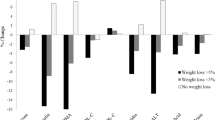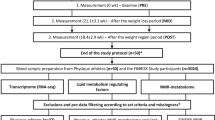Abstract
Purpose
Low-grade systemic inflammation due to obesity is considered to be the key link between obesity and obesity-related disorders. The hypothesis was tested that significant alterations in inflammatory markers and adipokines would occur over a multidisciplinary intervention and that these changes might also be important for improvement of cardiovascular risk factors.
Methods
Thirty-tree overweight adults completed a 6-month multidisciplinary intervention program to evaluate the effects of a personalized dietary program based on the individual’s resting metabolic rate (RMR) on anthropometric parameters, aerobic and anaerobic capabilities, metabolic profile, inflammation, and body image satisfaction. Body composition, physical activity, anaerobic capabilities, RMR, metabolic profile, and low-grade inflammation were measured. Diet composition and body image dissatisfaction were also assessed.
Results
After 6 months of multidisciplinary intervention the participants showed significantly decreased body weight, waist circumference (WC), and the inflammatory markers tumor necrosis factor-α, C-reactive protein, and visfatin. They also showed increased anti-inflammatory adiponectin and consequently decreased serum insulin, HOMA-IR, and total cholesterol. The important findings of the study were that reduction of sugars and saturated fatty acids in the diet, coupled with an increase in exercise, significantly correlated with reduction of WC and body mass index. In addition, positive correlations between ∆ BMI, ∆ WC, ∆ trunk fat, inflammation, and cardiovascular risk factors were demonstrated.
Conclusions
Weight loss in combination with increased physical activity, a negative energy balance, and diet adjustment was associated with lower inflammation and consequently with lower cardiovascular risk factors.

Similar content being viewed by others
References
Wang Z, Nakayama T (2010) Inflammation, a link between obesity and cardiovascular disease. Mediators Inflamm. doi:10.155/2010/535918
Shoelson SE, Goldfine AB (2009) Getting away from glucose: fanning the flames of obesity-induced inflammation. Nat Med 15:373–374
Fuentes E, Fuentes F, Vilahur G et al (2013) Mechanisms of chronic state of inflammation as mediators that link obese adipose tissue and metabolic syndrome. Mediators Inflamm. doi:10.1155/2013/136584
Seagle HM, Strain GW, Makris A et al (2009) Position of the American dietetic association: weight management. J Am Diet Assoc 109:330–346
Gagnon C, Brown C, Couture C et al (2011) A cost-effective moderate-intensity interdisciplinary weight-management programme for individuals with prediabetes. Diabetes Metab 37:410–418
Franz MJ, VanWormer JJ, Crain AL et al (2011) Weight-loss outcomes: a systematic review and meta-analysis of weight-loss clinical trials with a minimum 1-year follow-up. J Am Diet Assoc 107:1755–1767
Casazza K, Fontaine KR, Astrup A et al (2013) Myths, presumptions, and facts about obesity. N Engl J Med 368:446–454
Weck M, Bornstein SR, Barthel A, Blüher M (2012) Strategies for successful weight reduction-focus on energy balance. Dtsch Med Wochenschr 137:2223–2228
Dulloo AG, Jacquet J, Montani JP, Schutz Y (2012) Adaptive thermogenesis in human body weight regulation: more of a concept than a measurable entity? Obes Rev 13(Suppl 2):105–121
Sénéchal M, Arguin H, Bouchard DR et al (2012) Effects of rapid or slow weight loss on body composition and metabolic risk factors in obese postmenopausal women. A pilot study. Appetite 58:831–834
Caranti DA, de Mello MT, Prado WL et al (2007) Short- and long-term beneficial effects of a multidisciplinary therapy for the control of metabolic syndrome in obese adolescents. Metabolism 56:1293–1300
Greene NP, Martin SE, Crouse SF (2012) Acute exercise and training alter blood lipid and lipoprotein profiles differently in overweight and obese men and women. Obesity (Silver Spring) 20:1618–1627
Murphy MH, Blair SN, Murtagh EM (2009) Accumulated versus continuous exercise for health benefit: a review of empirical studies. Sports Med 39:29–43
Carnier J, Lofrano MC, Prado WL et al (2008) Hormonal alteration in obese adolescents with eating disorder: effects of multidisciplinary therapy. Horm Res 70:79–84
Lira FS, Rosa JC, Dos Santos RV et al (2011) Visceral fat decreased by long-term interdisciplinary lifestyle therapy correlated positively with interleukin-6 and tumor necrosis factor-α and negatively with adiponectin levels in obese adolescents. Metabolism 60:359–365
Chae JS, Paik JK, Kang R et al (2013) Mild weight loss reduces inflammatory cytokines, leukocyte count, and oxidative stress in overweight and moderately obese participants treated for 3 years with dietary modification. Nutr Res 33:195–203
Jurdana M, Petelin A, Černelič Bizjak M et al (2013) Increased visfatin levels in obesity and its association with anthropometric/biochemical parameters, physical activity and nutrition. e-SPEN J 8:e59–e67
Ainsworth BE, Haskell WL, Herrmann SD et al (2011) Compendium of physical activities: a second update of codes and MET values. Med Sci Sports Exerc 43:1575–1581
Wardle J, Johnson F (2002) Weight and dieting: examining levels of weight concern in British adults. Int J Obes Relat Metab Disord 26:1144–1149
Millstein RA, Carlson SA, Fulton JE et al (2008) Relationships between body size satisfaction and weight control practices among US adults. Medscape J Med 10:119
Jenko-Pražnikar Z, Petelin A, Jurdana M, Žiberna L (2013) Serum bilirubin levels are lower in overweight asymptomatic middle-aged adults: an early indicator of metabolic syndrome? Metabolism 62:976–985
Matthews DR, Hosker JP, Rudenski AS et al (1985) Homeostasis model assessment: insulin resistance and beta-cell function from fasting plasma glucose and insulin concentrations in man. Diabetologia 28:412–419
West JA, De Looy AE (2001) Weight loss in overweight subjects following low-sucrose or sucrose-containing diets. Int J Obes Relat Metab Disord 25:1122–1128
Parks EJ, Hellerstein MK (2000) Carbohydrate-induced hypertriacylglycerolemia: historical perspective and review of biological mechanisms. Am J Clin Nutr 71:412–433
Krauss RM, Blanche PJ, Rawlings RS et al (2006) Separate effects of reduced carbohydrate intake and weight loss on atherogenic dyslipidemia. Am J Clin Nutr 83:1025–1031
Minehira K, Bettschart V, Vidal H et al (2003) Effect of carbohydrate overfeeding on whole body and adipose tissue metabolism in humans. Obes Res 11:1096–1103
Collison KS, Zaidi MZ, Subhani SN et al (2010) Sugar-sweetened carbonated beverage consumption correlates with BMI, waist circumference, and poor dietary choices in school children. BMC Public Health 10:234
Summers LKM, Fielding BA, Bradshaw HA et al (2002) Substituting dietary saturated fat with polyunsaturated fat changes abdominal fat distribution and improves insulin sensitivity. Diabetologia 45:369–377
Beavers KM, Brinkley TE, Nicklas BJ (2010) Effect of exercise training on chronic inflammation. Clin Chim Acta 411:785–793
Calder PC, Ahluwalia N, Brouns F et al (2011) Dietary factors and low-grade inflammation in relation to overweight and obesity. Br J Nutr 106(Suppl. 3):S5–S78
Grulich-Henn J, Lichtenstein S, Hörster F et al (2011) Moderate weight reduction in an outpatient obesity intervention program significantly reduces insulin resistance and risk factors for cardiovascular disease in severely obese adolescents. Int J Endocrinol. doi:10.1155/2011/541021
Masquio DC, de Piano A, Sanches PL et al (2012) The effect of weight loss magnitude on pro-/anti-inflammatory adipokines and carotid intima-media thickness in obese adolescents engaged in interdisciplinary weight loss therapy. Clin Endocrinol 79:55–64
Varady KA, Jones PJH (2005) Combination diet and exercise interventions for the treatment of dyslipidemia: an effective preliminary strategy to lower cholesterol levels? J Nutr 135:1829–1835
Cnop M, Havel PJ, Utzschneider KM et al (2003) Relationship of adiponectin to body fat distribution, insulin sensitivity and plasma lipoproteins: evidence for independent roles of age and sex. Diabetologia 46:459–469
Chan DC, Watts GF, Ng TW et al (2008) Effect of weight loss on markers of triglyceride-rich lipoprotein metabolism in the metabolic syndrome. Eur J Clin Invest 38:743–751
Verreth W, Ganame J, Mertens A et al (2006) Peroxisome proliferator-activated receptor-alpha, gamma-agonist improves insulin sensitivity and prevents loss of left ventricular function in obese dyslipidemic mice. Arterioscler Thromb Vasc Biol 26:922–928
Blaine BE, Rodman J, Newman JM (2007) Weight loss treatment and psychological well-being a review and meta-analysis. J Health Psychol 12:66–82
Sabiston C, Castonguay A, Barnett T et al (2009) Body image and C-reactive protein in adolescents. Int J Obes 33:597–600
Lang HF, Chou CY, Sheu WH, Lin JY (2011) Weight loss increased serum adiponectin but decreased lipid levels in obese subjects whose body mass index was lower than 30 kg/m2. Nutr Res 31:378–386
Acknowledgments
The authors would like to thank all the subjects for their participation. The authors would also like to thank the nurses (Sabina Ličen and Tamara Štemberger Kolnik) of the Faculty of Health Sciences for taking blood samples, Vanja Pahor and the Izola General Hospital biochemical laboratory staff, and colleague Tamara Poklar Vatovec from the Faculty of Health Sciences for her technical support. The authors sincerely thank Nadja Plazar for supporting this study. They are also grateful to Peter Raspor and Anthony R. Byrne for proof reading the manuscript. The study was funded by the University of Primorska, Faculty of Health Sciences, for the project entitled “A multidisciplinary approach in the treatment of obesity”, by the Slovenian Research Agency (Programme P1-0386), and by the European Regional Development Fund, Cross-Border Cooperation Italy–Slovenia Programme 2007–2013 (EU strategic Project TRANS2CARE).
Conflict of interest
The authors declare that there are no conflicts of interest.
Author information
Authors and Affiliations
Corresponding author
Rights and permissions
About this article
Cite this article
Petelin, A., Bizjak, M., Černelič-Bizjak, M. et al. Low-grade inflammation in overweight and obese adults is affected by weight loss program. J Endocrinol Invest 37, 745–755 (2014). https://doi.org/10.1007/s40618-014-0102-9
Received:
Accepted:
Published:
Issue Date:
DOI: https://doi.org/10.1007/s40618-014-0102-9




